This behavior from a Great Blue Heron was new to me. Each of the following 7 images is presented in the order it was taken.
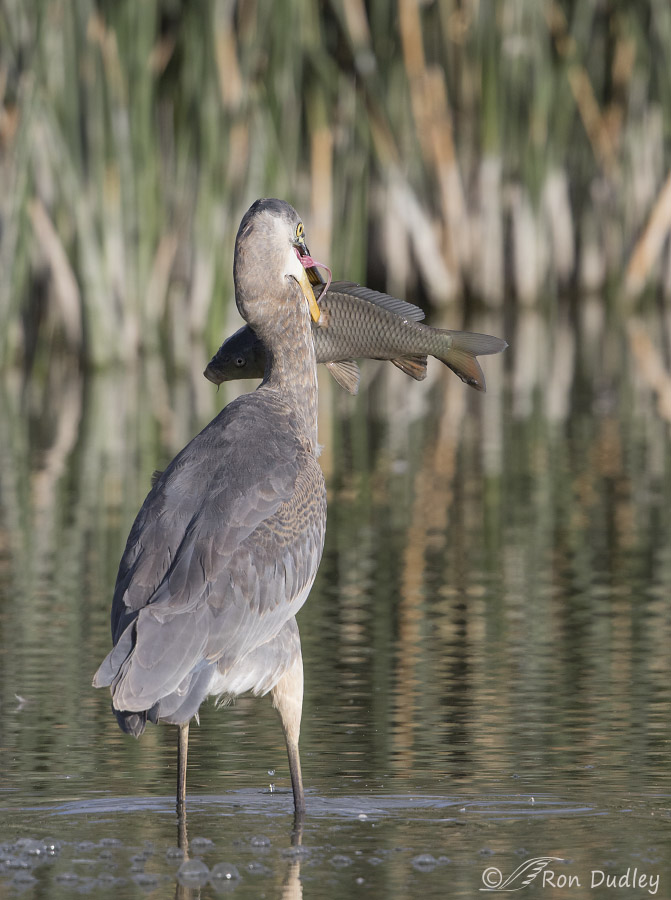
1/2000, f/6.3, ISO 400, Canon 7D Mark II, Canon EF500mm f/4L IS II USM +1.4 tc. not baited, set up or called in
When I first approached the bird yesterday morning at Bear River MBR it already had the fish, a large carp. At first it was still alive but based on its movement it wasn’t for long. I include this rear view because it gives us the best chance at judging the size of the carp (and because I like that flailing tongue).
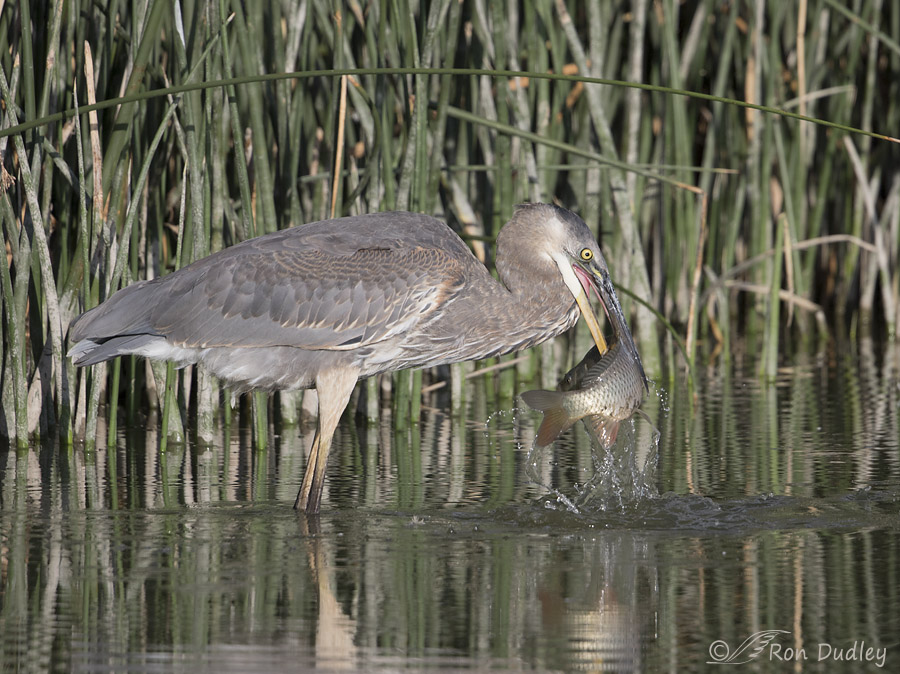
1/2000, f/6.3, ISO 400, Canon 7D Mark II, Canon EF500mm f/4L IS II USM +1.4 tc. not baited, set up or called in
The heron repeatedly dunked the fish in the water – usually with a significant amount of time (roughly 15 to 45 sec) between each dunk.
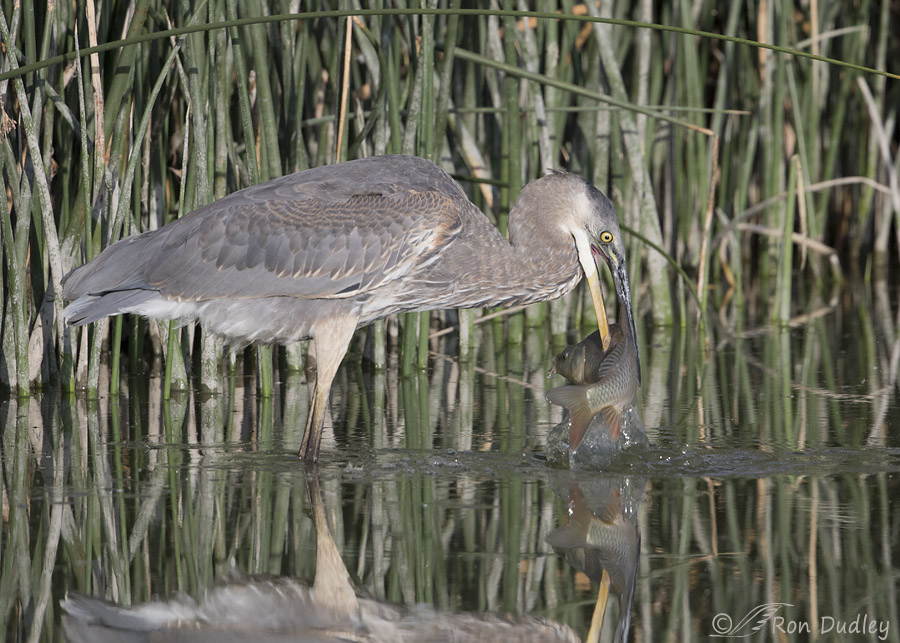
1/2000, f/7.1, ISO 500, Canon 7D Mark II, Canon EF500mm f/4L IS II USM +1.4 tc. not baited, set up or called in
Here it did it again. The fish was dunked roughly 10 times in the 6 minutes I spent with it.
At first I wondered if it was plunging the carp into the water in an attempt to get the fish off its bill because it had been impaled by the lower mandible but in reviewing my images I think not because the upper mandible was always clamped tightly down on the carp during the behavior. Nor did I see any other evidence that it was trying to get the fish off of its bill.
Because only the lower mandible penetrated the fish (something I’ve seen several times before) it makes me wonder if herons instinctively open their bill slightly during the strike to give them a better chance of one of the mandibles finding the target.
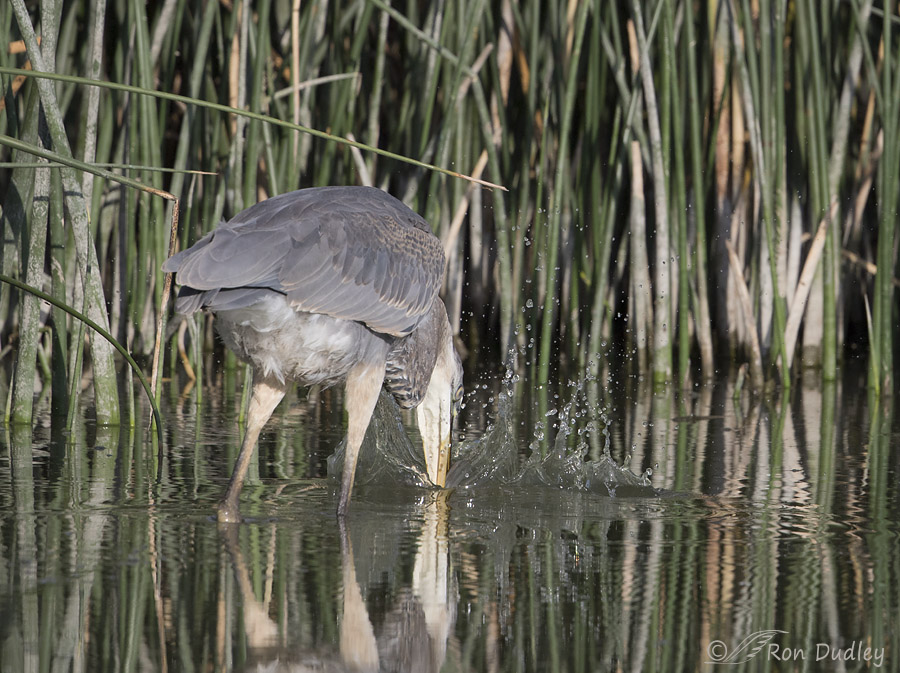
1/2000, f/7.1, ISO 500, Canon 7D Mark II, Canon EF500mm f/4L IS II USM +1.4 tc. not baited, set up or called in
At this point the heron apparently decided it wanted to attempt to swallow this large meal in private so it began walking toward the right side of the clump of vegetation so it could hide behind it but even during the short trek it continued to plunge the fish into the water.
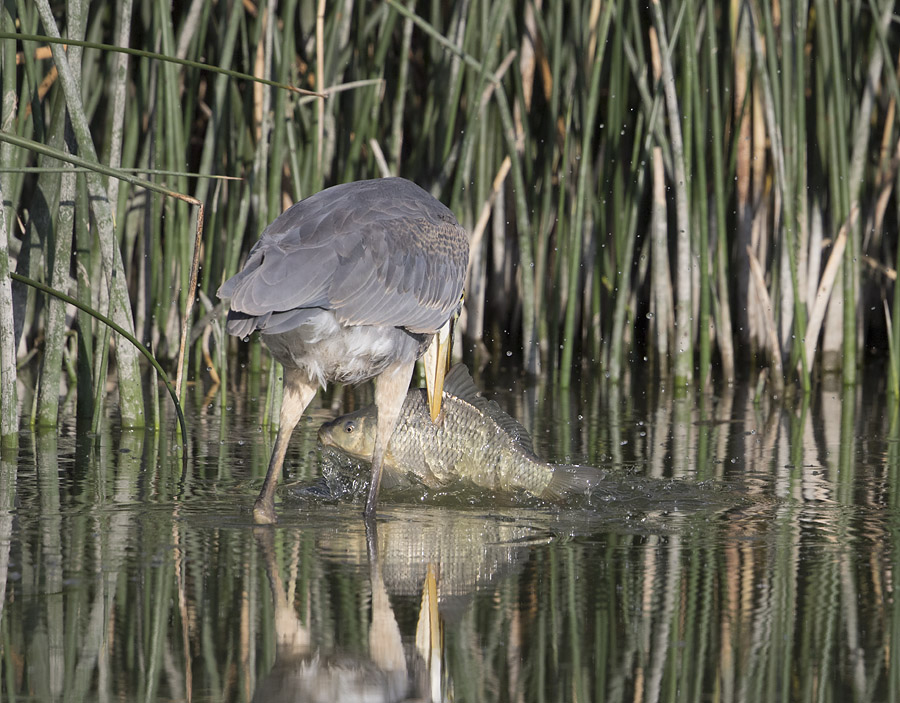
1/2000, f/6.3, ISO 400, Canon 7D Mark II, Canon EF500mm f/4L IS II USM +1.4 tc. not baited, set up or called in
Here the carp is still covered with a sheet of water as it’s being retrieved.
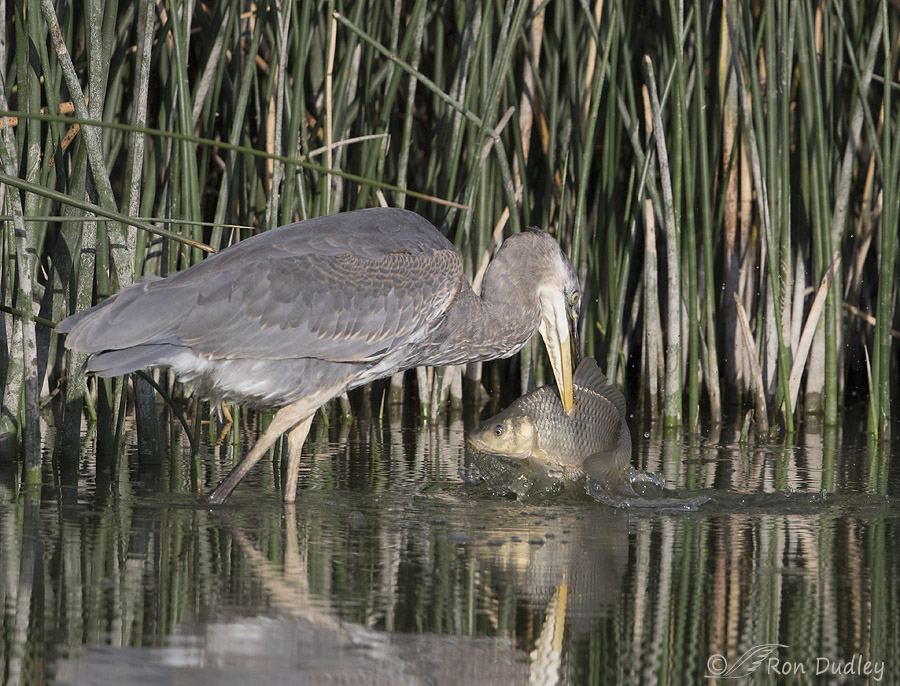
1/2500, f/7.1, ISO 500, Canon 7D Mark II, Canon EF500mm f/4L IS II USM +1.4 tc. not baited, set up or called in
Yet another dunk into the water.
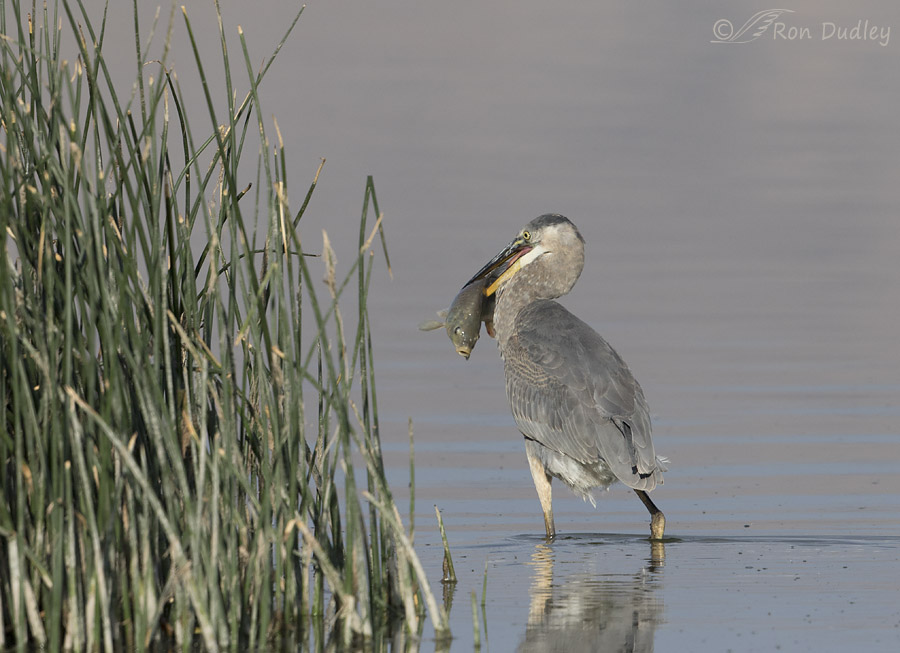
1/3200, f/7.1, ISO 500, Canon 7D Mark II, Canon EF500mm f/4L IS II USM +1.4 tc. not baited, set up or called in
Eventually the heron made it to the edge of the vegetation clump, walked around it and disappeared from view so I don’t know if it was able to swallow the large fish.
Perhaps this plunging behavior is common in the species but it was new to me and I can’t think of a purpose for doing so.
Ron
Note: Whenever I publish a post that involves carp I seem to get a lot of interest from readers in Europe and even Asia because their attitude toward the fish differs so remarkably from ours in North America. Here we generally think of them as trash fish but elsewhere they’re considered a trophy and excellent eating. Here in northern Utah carp are a scourge, largely because they displace native species and do an incredible amount of damage to wetland vegetation. Yesterday the Salt Lake Tribune published an interesting article on our attempts to control the carp population in nearby Utah Lake that I though some of my readers might be interested in.


Ron, when I was on Facebook a few minutes ago, I saw a series a friend of mine posted, of a Heron eating a very large fish. I was shocked to see that it was successful in swallowing a fish as large as this one. Here’s the link: https://www.facebook.com/tandcsavage/media_set?set=a.10153060783496606.1073742403.539531605&type=3
Thank you Susan. That is something.
I suppose we should call him John. I have never seen this behavior either. You pictures are always so interesting!
“I suppose we should call him John.”
Ha, loved that, Jean!
I wonder whether the lower mandible wasn’t stuck through the fish in such a way as to be jammed into place and therefore not so easily withdrawn, no matter the number of ablutions! It’s not definitive, by eye, but it has the look of being pierced through (by lower mandible) to me. And stuck between bones?
Could be, Tom. But the bird sure didn’t seem to be trying to get the fish off the bill as far as I could tell. The upper mandible was always closed tightly against the fish. I guess we’ll never know for sure…
I have observed this behavior with a Great Egret, in Bosque del Apache NWR, in New Mexico. The Egret caught the fish, which appeared too large for it to swallow. It dunked the fish repeatedly in the water, and worked the fish in his mandible, as if to tenderize the fish before eating. The fish would be crosswise in his clutches, then rotate 90 degrees, as though to swallow… but only to dunk again, and rotate. He continued this activity for over 20 minutes, and I had given up hopes of seeing him eat the fish. But he did! You could see the bulging outline of the large fish in his neck! Thereafter he flew to a new location.
Interesting, Dee. That sounds very close to what I observed with this GBH. Thanks for the report.
My ignorant self thinks it is definitely a case of ‘eyes bigger than stomach’.
If it did manage to get it down, flying would have to be a challenge for quite a while.
Love the shot with the carp still wrapped in a sheet of water particularly.
Thanks, EC. Yes, flight would probably be more difficult after a meal like that.
Ron, Bear River seems to be a gold mine of wildlife photo opps. Wondering if it is the same in last Jan, early Feb when I will be at Alta Skiing. Thinking of driving from Colorado and then taking a trip to Bear River for a few days. What do you think? thank you, Rich
Rich, I don’t visit Bear River as often that time of year because the ponds are typically frozen over so there’s not many birds. You’d probably have your best chance with Rough-legged Hawks and possibly harriers if they’ll let you get close. However, just north of Bear River the area around Golden Spike is often a great area for a variety of raptors that time of year, including Golden Eagles.
I have heard that many years ago they used to ship boxcar loads of carp or carp like fish (maybe buffalo fish) to Chicago where there was a large black population. I have eaten carp & other than boney (sp) and occasionally muddy tasting they are OK.
Curious as to why the dunking.
@Judy, don’t know how big your Koi are but when I lived in Wa. state we had a large koi pond. The heron visited frequently. For a while I just stocked it with cheap goldfish.
One morning I came out of the house & there was a heron between the house & the pond. I was so pi**ed I was going to grab him and wring his neck. Actually ran toward him. When he spread his wings for take off I said OH SH*T and backed off. He was big
The house had a 3′ roof overhang & the pond was 4′ from the house. He launched straight up & slightly out, made a 180º turn and flew back over the roof top away from me.
A beautiful take off.
They will try to take fish that they can’t sallow or fly with & end up killing them or injuring so bad they die. ;-(
I really enjoyed your story, David. Thanks for that. I have a friend who once had to rescue a GBH and she was most fearful of that long, stabbing beak.
Ron, this “pond” was a plastic wading pool that I had sunk into the ground so there was no depth for the fished to hided in. The concept was I could sit in the living room and watch ‘MY” fish, which were the heron’s snack.
I had no real ideal how big they were. I was about 5’6″ & could still stand up straight. So when the GBH spread his wings and straightened up for take off he was bigger than me. Talk about SHOCKED
Later we had a real koi pond in the yard with a depth of 4’ and straight sides. hehehe
I know that Herons can (and will, given the opportunity) eat like pigs, but I would be very surprised if this bird could swallow that fish. Love how the photos show the water coming off the fish. My education for today was seeing both the maxilla and mandible referred to as mandibles. I did look it up, so I know now that it’s correct to call them both mandibles, but I’d never heard that before.
Susan, I’ve always thought that the distinction between maxilla and mandible was a little vague – for the reason you mention and the fact that I first learned those terms as applying only to bones (or possibly to cartilage in the case of class Chondrichthyes).
Never noticed them dunking, but have often been amazed at the sized of the fish they can get down. Maybe he wanted the fish clean before swallowing or the added moisture to make it go down smoothly. Great series.
Jo, as slippery as fish are from mucus (slime) I can’t imagine that wetting them repeatedly would help. But what do I know…?
We name it “Carpa” and since the Middle Age when they were first introduced here they have spread significantly. Today we can find them almost everywhere from rivers to lagoons.
When natural conditions are good they can measure up to one meter and weigh 30 Kg and being very courageous and combative made them a very good trophy.
This seems not to be the case of your carp. Unless it is already dead I find it too resigned to it’s fate.
Very interesting behavior.
Jorge, it was very close to dead when I first got there and it apparently gave up the ghost very soon after that.
Interesting information on the perspective of the Portuguese toward carp – thanks for that.
Beautiful photo’s! I love the clarity of the detail on both bird and carp. Also interesting as my husband has opined that they couldn’t take a large butterfly koi I have in a stock tank – I was skeptical and am more so now!
Thank you, Judy. I hope your koi doesn’t test the swallowing abilities of the local herons!
My wife and I watched a Great Blue Heron try to eat a salmon (dead) that floated into the ponds from the river. Tried every position possible and kept dipping it in the water. He had it half way down and finally gave up and walked away from it. It was some show to watch, determination, but the salmon was just to big.
I’ve also seen them try to swallow big fish and eventually give up, Steve. Especially in the winter when they’re fishing off the ice at Farmington.
Why would they not try break it apart and then eat it?
Because they don’t really have the tools to do that, Steven – no hooked beak and no strong talons to pull against. BNA Online says ” Most prey are swallowed whole”.
When you don’t have a stun gun, you “baptize”. Judging from the size of that carp, I can’t help but wonder who ate who… Article was interesting…was surprised the carp were thrown back in, esp. If they were so concerned about them crowding everything else out and wanting to cut back their numbers….
“When you don’t have a stun gun, you “baptize”
Perhaps, Patty. But this fish barely wiggled its tail when I first got there and I never saw it move on its own after that.
Sensational series Ron!
Charlotte
Thanks, Charlotte.
Wonderful series, but Man, that is one big fish for the gullet it is about to go into!
I’ve seen herons eat fish and Bullfrogs that I thought were too big for them, yet they still were able to do it. Can’t imagine that this fish will fit, but my batting record for that kind of situation is not very good!!
I wish I knew if the heron was able swallow this one, Dick. Really disappointed that the bird hid on me.